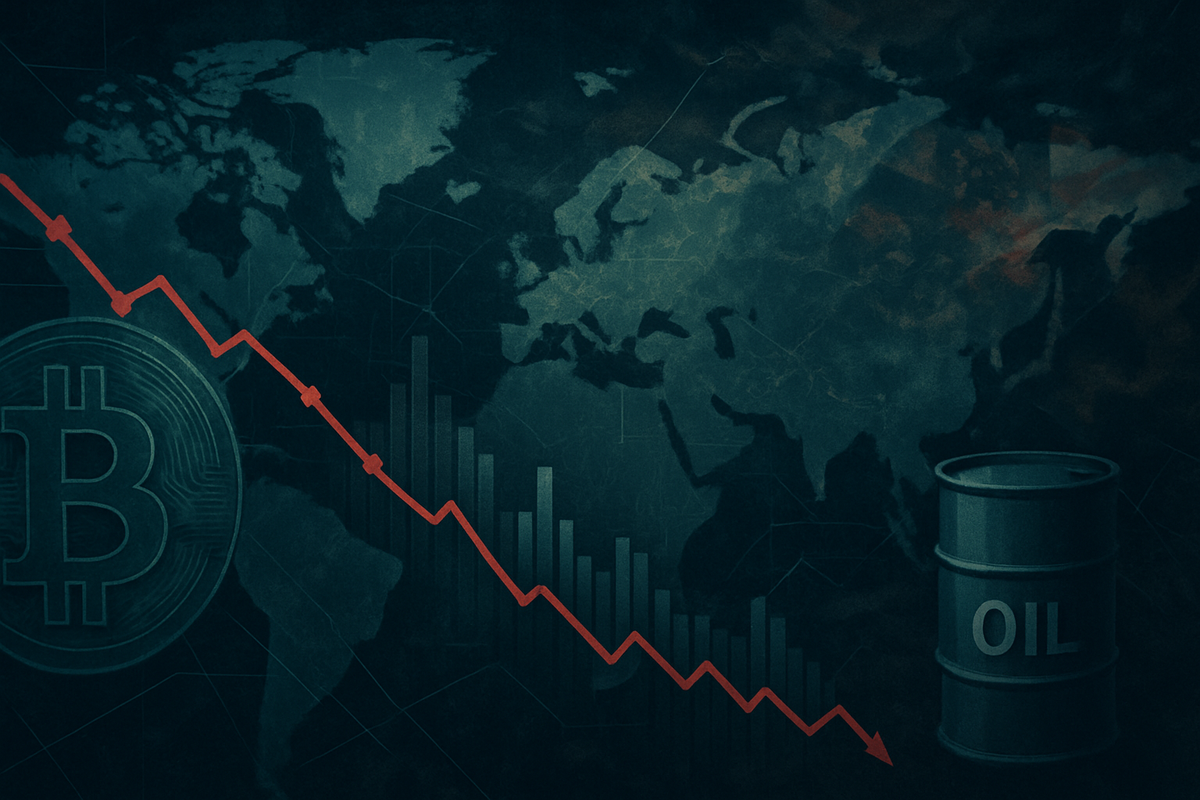
Global financial markets have been gripped by a wave of synchronized downturns, with cryptocurrency, traditional stocks, and oil prices experiencing significant dips from late 2024 through mid-2025, culminating in renewed volatility in October 2025. This broad-based correction, wiping billions from market capitalizations, is largely attributed to a potent cocktail of renewed US tariff policies, persistent geopolitical tensions, and an overarching concern for global economic growth. Investors are now navigating a landscape marked by heightened uncertainty, re-evaluating strategies amidst fears of stagflation and a potential global economic slowdown.
The immediate implications are clear: a stark increase in market volatility and a noticeable shift towards investor caution. While some assets, particularly in the crypto space, have shown resilience with a "buy the dip" mentality, the broader market sentiment remains fragile. The interconnectedness of these asset classes means that a shock in one sector quickly reverberates across others, creating a challenging environment for both institutional and retail investors.
A Cascade of Corrections: Tariffs and Tensions Drive Market Sell-Offs
The synchronized market dips have unfolded over several distinct periods, each triggered by a combination of macroeconomic and geopolitical factors. The most impactful catalysts have been the United States' aggressive stance on trade tariffs and escalating global conflicts. Late 2024 saw initial tremors, with the S&P 500 experiencing modest setbacks in October and December. However, the true downturn began in earnest from February to early April 2025. During this period, the S&P 500 entered bear market territory, registering a 21.4% intraday decline, while Bitcoin (BTC) plunged over 25% from its January peak, largely influenced by emerging US trade tariff concerns.
A pivotal moment arrived on April 2, 2025, dubbed "Liberation Day" by some market commentators, when global stock markets crashed following US President Donald Trump's announcement of sweeping new tariff policies targeting nearly all sectors of the US economy. This triggered widespread panic selling, marking the largest global market decline since the 2020 crash. The S&P 500, Nasdaq, and Dow Jones Industrial Average all suffered significant losses. Concurrently, Bitcoin experienced a sharp correction, dropping over 31% from its January 2025 high, directly correlating with the tariff announcement. More recently, October 2025 brought renewed instability. On October 9, oil prices dipped on news of a preliminary Israel-Hamas ceasefire agreement, easing Middle East tensions, while Dogecoin (DOGE) saw a 2% to 4% decline. The following day, October 10, the broader cryptocurrency market experienced one of its steepest single-day declines of the year, erasing nearly $280 billion from its market cap, with Bitcoin falling over 10% below $108,000. This crypto rout coincided with a 2.7% drop in the S&P 500, both triggered by President Trump's announcement of a 100% increase in levies on Chinese imports, effective November 1. Key stakeholders include central banks like the US Federal Reserve, major oil-producing nations, and global trade organizations, all grappling with the implications of these volatile market conditions.
Companies Navigating the Storm: Winners and Losers in a Volatile Market
The recent market turbulence presents a mixed bag for public companies across various sectors. In the cryptocurrency space, companies heavily invested in or reliant on digital asset performance face significant headwinds. Coinbase Global, Inc. (NASDAQ: COIN), a leading cryptocurrency exchange, is particularly vulnerable to reduced trading volumes and investor caution during bear markets, potentially impacting its transaction fee revenue. Similarly, companies like MicroStrategy Incorporated (NASDAQ: MSTR), which holds substantial Bitcoin reserves on its balance sheet, could see significant fluctuations in its equity value tied directly to Bitcoin's price movements. Regulatory uncertainties, such as the SEC's delayed approval for meme coin ETFs, also weigh on the prospects of various altcoin projects and related service providers.
Conversely, some entities might find opportunities amidst the chaos. For instance, traditional financial institutions with robust risk management frameworks and diversified portfolios may be better positioned to weather the storm. Furthermore, companies involved in cybersecurity or providing stablecoin services might see increased demand as investors seek safer havens or more secure digital transactions. In the oil sector, major integrated oil companies like ExxonMobil Corporation (NYSE: XOM) and Chevron Corporation (NYSE: CVX) are directly impacted by falling crude prices. While lower prices can squeeze upstream exploration and production profits, their diversified operations, including refining and chemicals, might offer some cushion. However, persistent low prices could lead to reduced capital expenditure and slower project development. Companies with high debt loads or those heavily focused on marginal production could face severe financial strain. On the flip side, industries that are major consumers of oil, such as airlines (e.g., Delta Air Lines, Inc. (NYSE: DAL)) and shipping companies, could see a reduction in operating costs, potentially boosting their profitability, assuming demand remains stable. However, a global economic slowdown, which is a key driver of the oil price dip, would ultimately dampen demand for their services as well.
Broader Implications: Stagflation Fears and Geopolitical Chess
The synchronized market dips are more than just isolated corrections; they signal deeper shifts in the global economic and geopolitical landscape. The re-emergence of aggressive US tariff policies, particularly against China, has reignited fears of a prolonged trade war, fitting into a broader trend of deglobalization and protectionism. This policy choice directly contributes to the specter of "stagflation" – a perilous combination of decelerating economic growth and accelerating inflation due to higher import costs. The Organization for Economic Cooperation and Development (OECD) has already projected a slowdown in US GDP growth for 2025, explicitly linking it to increased trade barriers and policy uncertainties.
Beyond trade, persistent geopolitical tensions continue to cast a long shadow. The ongoing Russia-Ukraine conflict, with its intensified drone campaigns against Russian oil infrastructure, and the volatile situation in the Middle East (e.g., Israel-Iran, Israel-Hamas) create a pervasive sense of uncertainty. While a potential Gaza ceasefire in October 2025 temporarily eased oil prices, the underlying instability remains a significant risk factor, contributing to expectations of increased macroeconomic volatility. Regulatory implications are also significant, especially for the nascent cryptocurrency market. The US government shutdown in October 2025, leading to furloughs at the SEC, has effectively halted reviews and delayed critical decisions on various altcoin ETFs, adding to market unease and hindering mainstream adoption. Historically, periods of intense trade disputes and geopolitical instability have often preceded global economic slowdowns, with parallels drawn to the late 1970s and early 1980s stagflationary environment, though the current context has its own unique drivers.
What Comes Next: Navigating a Path Through Uncertainty
Looking ahead, the short-term outlook for global markets remains highly dependent on policy decisions and geopolitical developments. A de-escalation of trade tensions, particularly between the US and China, could provide a much-needed boost to investor confidence and alleviate some of the stagflationary pressures. Conversely, further tariff hikes or an intensification of trade wars would likely exacerbate the current downturn, pushing global economies closer to a recessionary environment. For the cryptocurrency market, the resolution of regulatory uncertainties, particularly regarding ETF approvals, will be crucial. A favorable regulatory environment could unlock significant institutional capital, while continued delays or restrictive policies could prolong the bear market sentiment.
In the long term, companies will need to consider strategic pivots to adapt to this new reality. Supply chain diversification away from heavily tariffed regions, increased investment in automation to offset rising labor costs, and a greater focus on domestic markets could become priorities. Energy companies might need to accelerate their transition towards renewable sources if persistent oil price volatility makes traditional fossil fuel investments less predictable. Market opportunities may emerge for companies that can provide solutions for increased economic efficiency, cybersecurity, or alternative investment vehicles. Conversely, companies heavily reliant on global trade or discretionary consumer spending will face significant challenges. Potential scenarios range from a "soft landing" where central banks successfully manage inflation without triggering a deep recession, to a more severe "hard landing" characterized by prolonged economic contraction and heightened market distress.
Comprehensive Wrap-Up: A Test of Resilience and Adaptation
The synchronized dips across cryptocurrency, traditional stocks, and oil prices represent a significant test of market resilience and investor fortitude. Key takeaways from this period of volatility include the profound impact of trade policies on global markets, the enduring influence of geopolitical tensions, and the delicate balancing act faced by central banks in managing inflation without stifling growth. The market moving forward will likely be characterized by continued sensitivity to macroeconomic data, central bank communications, and geopolitical headlines.
Investors should watch closely for any shifts in trade policy rhetoric, progress in global conflict resolutions, and inflation indicators. The US Federal Reserve's interest rate policy will remain a critical factor; while they have begun a cycle of cuts, core inflation remains a concern, suggesting a cautious approach to further easing. Companies with strong balance sheets, diversified revenue streams, and adaptable business models are best positioned to navigate this uncertain environment. Ultimately, this period underscores the interconnectedness of global finance and the necessity for a nuanced, informed approach to investment in an increasingly complex world.
This content is intended for informational purposes only and is not financial advice





